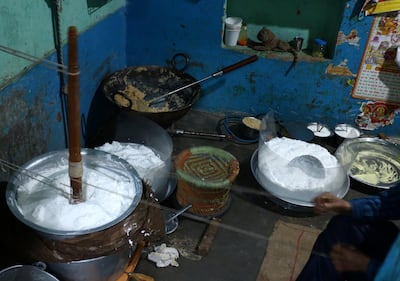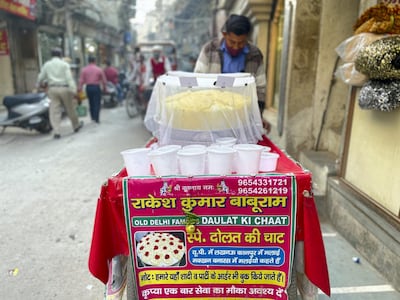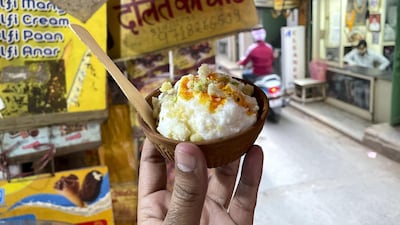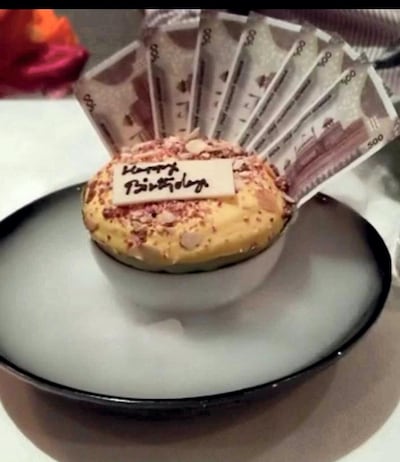Legend has it that all it takes is the dew from a cold winter moonlit night to turn a pot of milk into an ethereal dessert that goes by the name of daulat ki chaat. Indeed, even today, in parts of northern India, traditional makers of this sweet work through the nights to churn huge cauldrons of milk into a delicate froth, adding sugar and saffron as they go, as well as a liberal garnish of nuts and silver foil. The result is an opulent yet light dessert that has a nutty sweetness and a foamy melt-in-the-mouth consistency.
Mystical origins
Traditionally, daulat ki chaat was only made in the winter months, from Diwali (the autumnal festival of lights) to Holi (the spring festival of colours). The dessert is said to have travelled to India from Afghanistan. Some food historians believe that it was first made by the Botai tribe of Kazakhstan using mare’s milk. In India, daulat ki chaat finds mention in the Mughal courts; princess Jahanara, daughter of the emperor Shah Jahan, is said to have designed the empire’s first “resort” at Chandni Chowk in Delhi, and daulat ki chaat was a must-have there during the winters.
Its name, too, is interlaced with numerous tales. “Daulat” means “wealth” and chaat refers to a savoury mixture. One interpretation is that since the dessert contains a lot of milk, dry fruits and saffron, it was originally meant for the upper classes. Another theory says it is so delicate that it should be treated like something precious. Yet another explanation is that, just like wealth, the sweet too vanishes in no time when consumed. Of course, these theories don’t count when you visit other parts of India, where the dessert is known by different names – from malai makhan in Kanpur to nimish in Lucknow.
Arduous preparation
Preparing the dessert is not easy and involves several techniques, hard work and sleepless nights. One small mistake can ruin an entire batch, says Rakesh Kumar Baburam, a vendor in Chandni Chowk, who invites me to watch the sweet being prepared. So one cold winter night, I make my way through a warren of bylanes. What was once a palatial house has been divided into small living quarters with a common courtyard, where Baburam lives with his wife and children.
“The preparation begins the previous evening,” he says “We first boil the milk, add some cream and leave it in the open to become cold.” Baburam does not trust the packaged options, and gets seven or eight litres of milk fresh every morning.

“At 3am, we start churning the milk with a mathani [traditional wooden mallet].” It’s a process that takes up to four hours. Once the milk becomes frothy, the foamy layers are skimmed into an earthen pot. This is then left for a few hours in the open. “The early morning dew makes it light and frothy. This entire process costs us our night’s sleep,” says Baburam.
The sweet is then carefully transferred on to large pans that are placed on blocks of ice. Sugar powder and saffron are added, and the last step is embellishing the stuff with silver foil, before it is ready to be taken to the marketplace.
"This recipe is an art. I learnt it from my grandfather, and I don't know from whom he learnt it, but [our family] have been making this sweet for at least 100 years," says Baburam, who sells the dessert from a colourful cart equipped with blocks of ice to keep it cool, and a fine muslin cloth to protect it against dust and flies. The dessert is best consumed fresh in the morning hours before the sun melts it. Khemchand Adesh Kumar is another famed vendor in Chandni Chowk, with both Kumar and Baburam originally from the northern Indian state of Uttar Pradesh.

Technological intervention
In recent decades, mechanisation has made work a little easier for makers of the dessert, especially the advent of electricity. The use of ice and refrigeration means the sweet can be kept for a little longer, says Baburam. Fellow vendor Nishant Gupta adds: “Earlier one had to wait for cool weather, frosty nights and moonlight.” Electric churns are also available, but traditional hand-operated wooden mathanis are still preferred among those in the know in the bylanes of Old Delhi.
Thanks to technology, though, daukat ki chaat now appears on the menu of many high-end restaurants in India and abroad. Chef Manish Mehrotra of Indian Accent says he uses nitrogen capsules to cool the milk before whisking up the foam. Nuts and candied rose petals are added for crunch, and the dessert is presented in a terracotta pot exuding cold smoke for added drama.
In the UAE, try this mouthwatering dish at Tresind. The fusion Indian restaurant serves its daulat ki chaat with crumbling flakes of soan papdi, decorated with pistachio and gold dust, the latter touch a fitting ode to its name.


